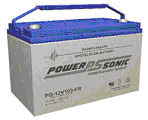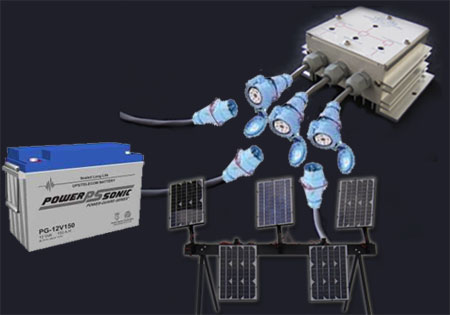Solar panels aren’t just for endlessly powering your pocket calculator anymore. Not only are they gaining popularity because of their low-maintenance, quite, and streamlined design, but also, advances in technology are sure to lower the price. Many innovations are led by semiconductor firms and a new crop of "thin-film" solar makers with designs that bring more power from sunlight, use less silicon to make panels, and make factories more efficient. According to USA Today, Wal-Mart recently said it's putting solar panels on more than 20 of its stores in California and Hawaii, and Google (GOOG) is blanketing its Mountain View, Calif., headquarters with 9,212 solar panels, enough to light 1,000 homes. This high demand coupled with surging sales and advances in manufacturing is sure to further reduce the price and bring solar power to more applications. Some experts say that the solar market could overtake the semiconductor market.
The four primary components for producing electricity using sunlight are solar panels, charge controller, battery, and inverter. Solar panels charge the battery, and the charge regulator insures proper charging of the battery. The battery provides DC voltage to the inverter, and the inverter converts the DC voltage to normal AC voltage. If 240 volts AC is needed, then either a transformer is added or two identical inverters are series-stacked to produce the 240 volts.

Solar Panels
Output of a solar panel is usually stated in watts, and the wattage is determined by multiplying the rated voltage by the rated amperage. The formula for wattage is VOLTS times AMPS equals WATTS. So for example, a 12 volt 60 watt solar panel measuring about 20 X 44 inches has a rated voltage of 17.1V and a rated amperage of 3.5A.
Solar panels can be wired in series or in parallel to increase voltage or amperage respectively, and they can be wired both in series and in parallel to increase both volts and amps.
A charge controller monitors the battery's state-of-charge to insure that when the battery needs charge-current it gets it, and also insures the battery isn't over-charged.
The most advanced charge controllers utilize a charging principal referred to as Pulse-Width-Modulation (PWM) - which insures the most efficient battery charging and extends the life of the battery. Even more advanced controllers also include Maximum Power Point Tracking (MPPT) which maximizes the amount of current going into the battery from the solar array by lowering the panel's output voltage, which increases the charging amps to the battery - because if a panel can produce 60 watts with 17.2 volts and 3.5 amps, then if the voltage is lowered to say 14 volts then the amperage increases to 4.28 (14v X 4.28 amps = 60 watts) resulting in a 19% increase in charging amps for this example.
Battery
 The deep cycle batteries used are designed to be discharged and then re-charged hundreds or thousands of times. These batteries are rated in Amp Hours (ah) - usually at 20 hours and 100 hours. Simply stated, amp hours refers to the amount of current - in amps - which can be supplied by the battery over the period of hours. For example, a 350ah battery could supply 17.5 continuous amps over 20 hours or 35 continuous amps for 10 hours. To quickly express the total watts potentially available in a 6 volt 360ah battery; 360ah times the nominal 6 volts equals 2160 watts or 2.16kWh (kilowatt-hours). Like solar panels, batteries are wired in series and/or parallel to increase voltage to the desired level and increase amp hours.
The deep cycle batteries used are designed to be discharged and then re-charged hundreds or thousands of times. These batteries are rated in Amp Hours (ah) - usually at 20 hours and 100 hours. Simply stated, amp hours refers to the amount of current - in amps - which can be supplied by the battery over the period of hours. For example, a 350ah battery could supply 17.5 continuous amps over 20 hours or 35 continuous amps for 10 hours. To quickly express the total watts potentially available in a 6 volt 360ah battery; 360ah times the nominal 6 volts equals 2160 watts or 2.16kWh (kilowatt-hours). Like solar panels, batteries are wired in series and/or parallel to increase voltage to the desired level and increase amp hours.
One of the biggest mistakes made by those just starting out is lack of understanding of the relationship between amps and amp-hour requirements of 120 volt AC items versus the effects on their DC low voltage batteries. For example, say you have a 24 volt nominal system and an inverter powering a load of 3 amps, 120VAC, which has a duty cycle of 4 hours per day. You would have a 12 amp hour load (3A X 4 hrs=12 ah). However, in order to determine the true drain on your batteries you have to divide your nominal battery voltage (24v) into the voltage of the load (120v), which is 5, and then multiply this times your 120vac amp hours (5 x 12 ah). So in this case the calculation would be 60 amp hours drained from your batteries - not the 12 ah. Another simple way is to take the total watt-hours of your 120VAC device and divide by nominal system voltage. Using the above example; 3 amps x 120 volts x 4 hours = 1440 watt-hours divided by 24 DC volts = 60 amp hours.
Lead-acid batteries are the most common in PV systems because their initial cost is lower and because they are readily available nearly everywhere in the world. There are many different sizes and designs of lead-acid batteries, but the most important designation is that they are deep cycle batteries.
Inverter
 An inverter is a device which changes DC power stored in a battery to standard 120/240 VAC electricity (also referred to as 110/220). Most solar power systems generate DC current which is stored in batteries. Nearly all lighting, appliances, motors, etc., are designed to use ac power, so it takes an inverter to make the switch from battery-stored DC to standard power (120 VAC, 60 Hz).
In an inverter, direct current (DC) is switched back and forth to produce alternating current (AC). Then it is transformed, filtered, stepped, etc. to get it to an acceptable output waveform. More processing equals cleaner and quieter output, but lower efficiency of the conversion. The goal becomes to produce a waveform that is acceptable to all loads without sacrificing too much power in the conversion process.
Inverters come in two basic output designs - sine wave and modified sine wave. Most 120VAC devices can use the modified sine wave, but there are some notable exceptions. Devices such as laser printers which use triacs and/or silicon controlled rectifiers are damaged when provided mod-sine wave power. Motors and power supplies usually run warmer and less efficiently on mod-sine wave power. Some things, like fans, amplifiers, and cheap fluorescent lights, give off an audible buzz on modified sine wave power. However, modified sine wave inverters make the conversion from DC to AC very efficiently. They are relatively inexpensive, and many of the electrical devices we use every day work fine on them.
An inverter is a device which changes DC power stored in a battery to standard 120/240 VAC electricity (also referred to as 110/220). Most solar power systems generate DC current which is stored in batteries. Nearly all lighting, appliances, motors, etc., are designed to use ac power, so it takes an inverter to make the switch from battery-stored DC to standard power (120 VAC, 60 Hz).
In an inverter, direct current (DC) is switched back and forth to produce alternating current (AC). Then it is transformed, filtered, stepped, etc. to get it to an acceptable output waveform. More processing equals cleaner and quieter output, but lower efficiency of the conversion. The goal becomes to produce a waveform that is acceptable to all loads without sacrificing too much power in the conversion process.
Inverters come in two basic output designs - sine wave and modified sine wave. Most 120VAC devices can use the modified sine wave, but there are some notable exceptions. Devices such as laser printers which use triacs and/or silicon controlled rectifiers are damaged when provided mod-sine wave power. Motors and power supplies usually run warmer and less efficiently on mod-sine wave power. Some things, like fans, amplifiers, and cheap fluorescent lights, give off an audible buzz on modified sine wave power. However, modified sine wave inverters make the conversion from DC to AC very efficiently. They are relatively inexpensive, and many of the electrical devices we use every day work fine on them.
AC Disconnect
Many utilities require a separate AC disconnect to isolate the solar power system from utility power. Most solar power systems also include a DC disconnect to isolate the array output from the inverter. This is used in the event of a power outage from your local utility. Your solar array is still producing power and could feed power into the grid via the electrical lines while the utility repairperson is trying to solve the outage problem.
Connecting to the Grid

Sources:
http://www.usatoday.com/tech/science/environment/2007-08-26-solar_N.htm
http://www.solar4power.com/solar-power-basics.html
http://apps1.eere.energy.gov/consumer/your_home/electricity/index.cfm/mytopic=10530